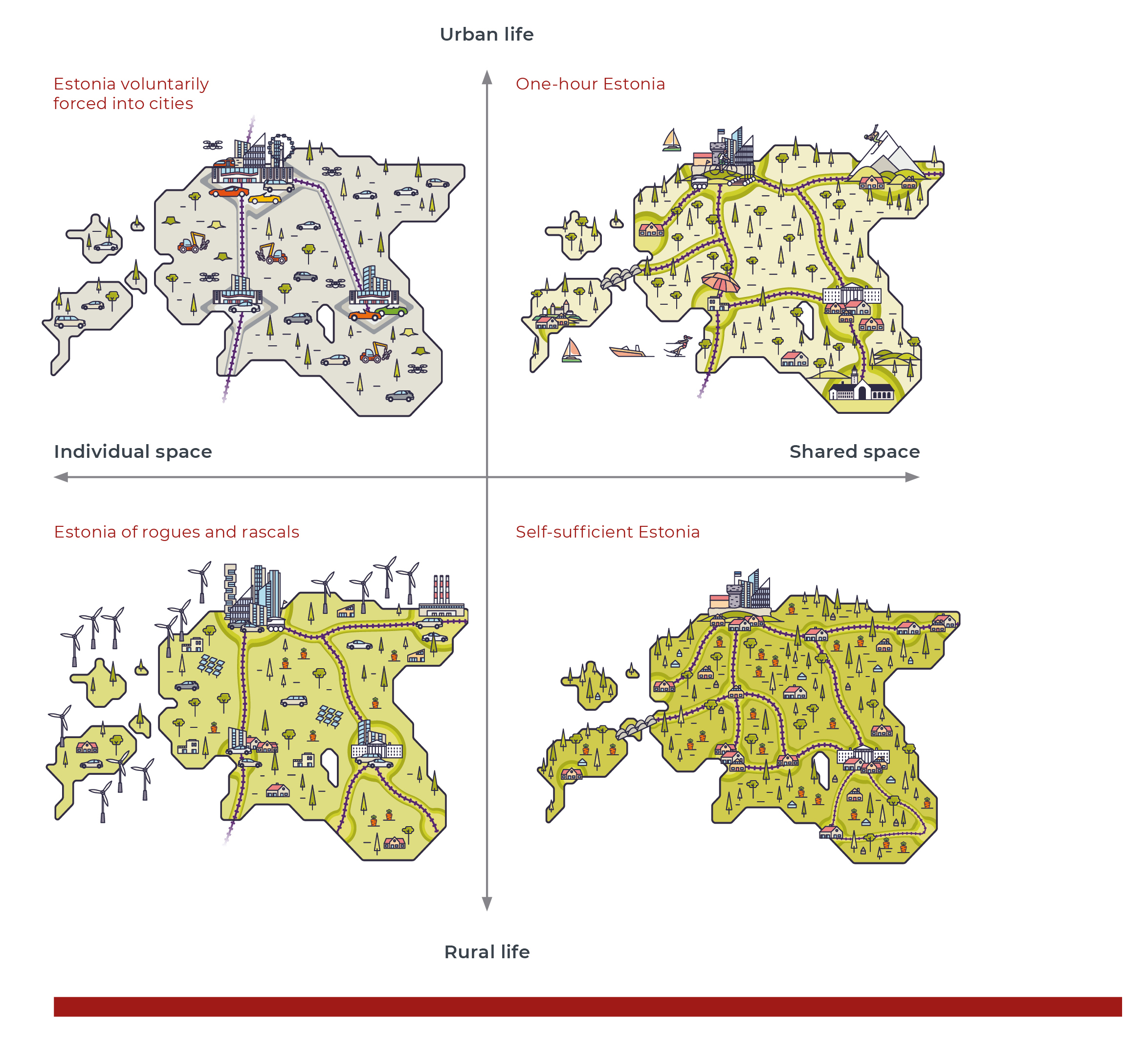Estonia 2050 scenarios
Four scenarios were developed to illustrate the impact of the changes described above. The scenarios are exploratory and illustrate a range of possible futures. Exploratory scenarios differ from other types of scenarios (forecasts and normative scenarios) in that they focus on the combined effects of different variables and do not specify a specific objective that must be achieved in all scenarios (Börjeson 2006). The role of exploratory scenarios is to illustrate the possible extremes of each axis, which need not materialise. For example, in the case of public space, it is difficult to imagine a completely individualistic (liberal) or entirely communal use, while there may be a tendency to go more in one direction or the other.
The role of exploratory scenarios is to illustrate the possible extremes of each axis.
The axes of the scenarios have been chosen to cover both the changes taking place in the Estonian settlement structure on a wider scale and the developments of public space on a narrower scale. Changes with a global reach (e.g. climate change, self-driving vehicles) are used selectively in the future scenarios to illustrate the consequences of the combined effects of such changes. The axes of the scenarios were selected and the preliminary drafts were prepared in the workshops with all the chapter editors of this report (Figure 5.5).
The happiness index cited in the scenarios is not a specific index but a new index used in the future world; it combines indicators of responsible economic growth, sustainable development, and people’s assessment of the happiness of their lives and their physical and mental health.
The main axes of the future scenarios are settlement structure and public space. Four scenarios arise from the two axes. Life in Estonia in different futures is described through stories. The scenario stories describe the future in the present tense, either through a general description or through the eyes of a character (Schwartz 1991). The scenarios are intentionally written as vivid stories to highlight their differences and encourage the reader to engage with the narrative. The purpose of the scenarios is to acknowledge the consequences of potential changes.
The settlement structure axis shows the inhabitants’ preferences for place of residence and regional development trajectories. The upper end of the axis is based on forecasts (Statistics Estonia 2018), according to which the population will concentrate in larger cities. Urban regions are growing faster, while the growth of city centres remains rather moderate. The lower end of the axis (life in the country) is based on balanced regional development whereby the share of urban populations does not increase or even decreases. For this trend to materialise, it is necessary to counterbalance the competitive advantage of cities, for example, using distributed innovation, whereby investments are directed to shrinking local and regional centres and low-density areas in order to diversify innovation projects, services and economic activities. Currently, 69% of the population lives in urban and small-town settlements (Statistics Estonia 2019); 45% of the population is concentrated in Harjumaa, Tartumaa and Pärnumaa counties. In 1989, 71% of the population lived in urban areas. According to the baseline scenario of Statistics Estonia’s population forecast (2019), the share of the population of these three counties will be 71% by 2040.
The public space axis shows the role of public space in society, with a more specific focus on data, mobility and accessibility issues. At the individual space end of the axis, the average citizen has access to public space and services according to their individual consumption capacity. Access to data, mobility services and public space (e.g. green spaces) depends on income and social status. At the shared space end of the axis, all members of society are guaranteed equal access to the public good in terms of data, public space and mobility services. Being a member of the community and contributing to joint activities is valued.
Figure 5.5. Estonia 2050 living environment scenarios on the axes of settlement structure and public space

Source: Figure by the author.